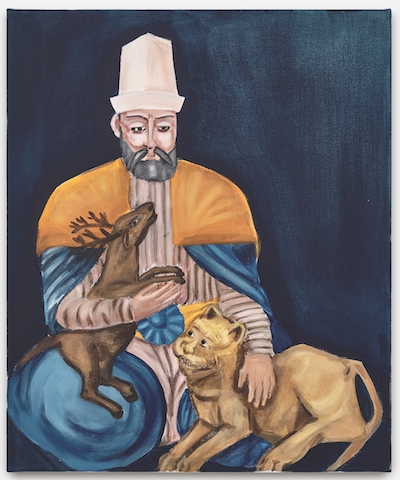Melike Kara uses her first gallery show in her hometown of Cologne to question everything that ‘home’ means to her. Born and raised in Germany, she’s also part of a Kurdish Alevi family forced to flee Turkey because of the persecution of their culture. Nestling in a cross-media arrangement of works, the highly personal video Emine (all works 2018) portrays the artist’s grandmother from a respectful distance. The old lady, marked by life, moves unsurely through her own home: Alzheimer’s is gradually erasing her awareness of her identity. With this loss, meanwhile, goes part of the family’s Kurdish identity, as Emine is the only one who still speaks Zazaki, the language of their homeland in eastern Turkey.
The wall piece fal (a) bakmak (‘reading coffee grounds’) also refers to the grandmother, siting her as keeper of Kurdish rites. About 300 mocha cups are embedded into a wall in a huge grid. Each cup contains, indeed, coffee grounds, whose portents the exhibition’s visitors – unlike Kara’s grandmother, who practises tasseomancy – probably won’t be able to read. It’s not only the past that dims without the grandmother but also the future. Accordingly, fal (a) bakmak light-footedly bridges both identities of the artist as part of a globalised international art clique and a nearly archaic national community. Pointedly, the coffee grounds of this Turkish magic are embedded in a vocabulary – the grid – that resembles Minimalism, whose universal claim famously marks the beginning of a uniform, transnational form of expression.
It’s instructive also to regard the constellations of figures in front of a white background – resembling the paintings for which Kara is best known – as closed societies. Their interactions are opaque to outsiders and their codes inscrutable, which is to some degree the case with both minority ethnic communities and the artworld. And yet there are also explicit hints of the artist’s Kurdish origin in these groups of figures, which merge into homogeneous groups, social bodies, using calculated colour concepts. For example, there’s the fat goat that stares at the viewer in Munzur (like she shapes us), blocking large parts of figures, whose silhouettes barely emerge from the sloppily applied sandy tone of the creature’s fur. The animal here serves again as code for a traditional, antiquated Kurdish lifestyle, with its ritualised goat slaughtering that clearly traumatised the artist at a young age.
The pairing of two other paintings stands out. On the righta group of figures with a goat, Tiefe Schluchten langer Schnee (‘deep canyon, long snow’), sketched in quick, light brown oil pastel outlines accentuated here and there with washed-out pink; on the left, the neatly painted Haci BektaşVeli (Hadschi Bektasch Wali), a depiction of a spiritual leader from the thirteenth century, adored by the Alevis. He holds in his arm a miniature stag; on his lap rests a predatory cat. The depiction of the saint reads as a condensed image of the influence on the artist of her heritage and family background. At the same time Haci Bektaş Veli is a fitting counterpart to the aforementioned video Emine, in which at one point a giant lion is inserted, digitally, into the grandma’s living room. In the stylistically very different Tiefe Schluchten langer Schnee, by contrast, men and goats – both rendered in a profane, expressive vocabulary – are barely distinguishable from each other. The painting brings to mind the artist’s raw, sketchy compositions from four or five years ago and thereby also functions as a guide to the reading of her recent paintings. Kara has refined the distinguishing features of the figures in her constellation, so that now they recall the masks of Noh theatre, which appear near-identical to those unfamiliar with the codes of the form yet reveal subtle differences to those in the know.
Translated from the German by Liam Tickner
Melike Kara: Speaking in Tongues at Jan Kaps, Cologne, 14 December – 10 February
From the March 2019 issue of ArtReview
